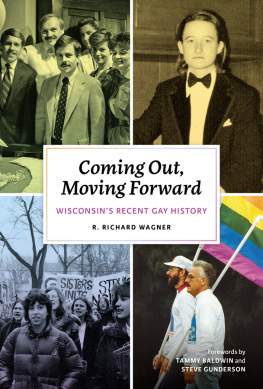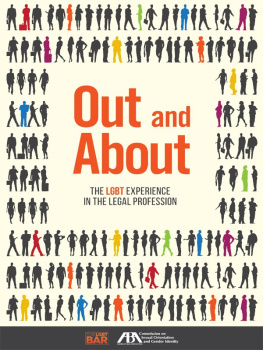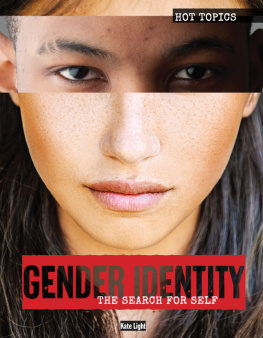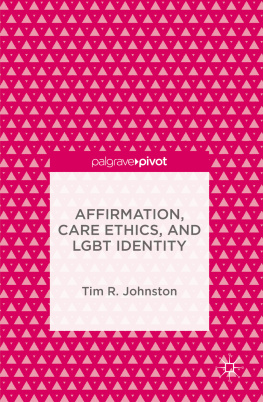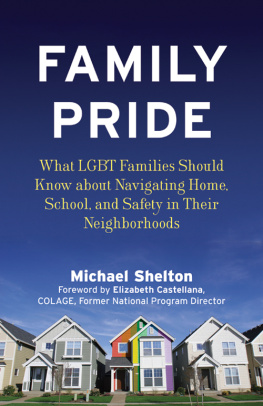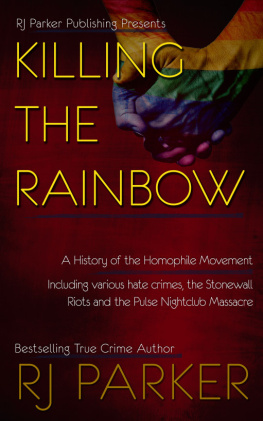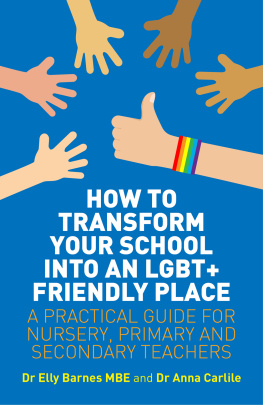Coming Out and Disclosures
LGBT Persons Across the Life Span
THE HAWORTH PRESS
Titles of Related Interest
Acts of Disclosure: The Coming-Out Process of Contemporary Gay Men by Marc E. Vargo
Creating Safe Environments for LGBT Students: A Catholic Schools Perspective edited by Michael J. Bayly
How Homophobia Hurts Children: Nurturing Diversity at Home, at School, and in the Community by Jean M. Baker
Homosexual Rites of Passage: A Road to Visibility and Validation by Marie Mohler
Homosexuality and the Family edited by Frederick W. Bozett
Lesbian Epiphanies: Women Coming Out in Later Life by Karol L. Jensen
Midlife and Older GLBT Adults: Knowledge and Affirmative Practice for the Social Services by Ski Hunter
Gay and Gray: The Older Homosexual Man, Second Edition by Raymond M. Berger
Reeling in the Years: Gay Mens Perspectives on Age and Ageism by Tim Bergling
Whistling Women: A Study of the Lives of Older Lesbian Women by Cheryl Claasen
Midlife Lesbian Relationships: Friends, Lovers, Children, and Parents edited by Marcy R. Adelman
Coming Out and Disclosures
LGBT Persons Across the Life Span
Ski Hunter, PhD
First Published by
The Haworth Press, Inc., 10 Alice Street, Binghamton, NY 139041580.
Transferred to Digital Printing 2009 by Routledge
270 Madison Ave, New York NY 10016
2 Park Square, Milton Park, Abingdon, Oxon, OX14 4RN
For more information on this book or to order, visit
http://www.haworthpress.com/store/product.asp?sku=5423
or call 1-800-HAWORTH (800-429-6784) in the United States and Canada
or (607) 722-5857 outside the United States and Canada
or contact
2007 by The Haworth Press, Inc. All rights reserved. No part of this work may be reproduced or utilized in any form or by any means, electronic or mechanical, including photocopying, microfilm, and recording, or by any information storage and retrieval system, without permission in writing from the publisher.
PUBLISHERS NOTE
The development, preparation, and publication of this work has been undertaken with great care. However, the Publisher, employees, editors, and agents of The Haworth Press are not responsible for any errors contained herein or for consequences that may ensue from use of materials or information contained in this work. The Haworth Press is committed to the dissemination of ideas and information according to the highest standards of intellectual freedom and the free exchange of ideas. Statements made and opinions expressed in this publication do not necessarily reflect the views of the Publisher, Directors, management, or staff of The Haworth Press, Inc., or an endorsement by them.
Cover design by Jennifer M. Gaska.
Library of Congress Cataloging-in-Publication Data
Hunter, Ski.
Coming out and disclosures: LGBT persons across the life span / Ski Hunter.
p. cm.
Includes bibliographical references.
ISBN: 978-0-7890-2689-7 (hard : alk. paper)
ISBN: 978-0-7890-2690-3 (soft : alk. paper)
1. Coming out (Sexual orientation)United States. 2. Social work with sexual minoritiesUnited States. I. Title.
HQ73.3.U6H86 2007
306.760973dc22
2006038188
This book is dedicated to Andrea who is central to my life.
She supported me throughout the writing of this book.
Writing is a solitary process, and I deeply appreciate
that she was present and helpful in so many ways.
About the Author
Ski Hunter, PhD, MSW, is a professor at the School of Social Work, University of Texas at Arlington. Among the courses she teaches is a course on LGBT issues. She has presented numerous workshops on this topic. Dr. Hunter has authored two books on midlife, including Midlife and Older LGBT Adults: Knowledge and Affirmative Practice for the Social Services. She was also the lead author of Lesbian, Gay, and Bisexual Youths and Adults published in 1998, co-author of Lesbian, Gay, Bisexual, and Transgender Issues in Social Work published in 2001, and lead author of Affirmative Practice: Understanding and Working with Gay, Bisexual, and Transgender Persons.
CONTENTS
Acknowledgments
I express gratitude to all LGBT persons who helped pave the way for many others to come out and make disclosures.
Introduction
Lesbian, gay, and bisexual are terms applied to sexual identities and infer sexual orientations. Transgender and intersex are terms applied to identities only and do not infer sexual orientations. Yet, LGBTI persons have to contend with stigma, prejudice, discrimination, harassment, and violence. LGBT persons also want legal protections and civil rights as well as sexual freedom and freedom for sex-gender expression. A major goal for intersex persons is freedom from surgical decisions about gender soon after birth, as they could turn out to be the wrong decisions. All these persons also have in common coming out to themselves and disclosing information to others about their identities. Literature on these processes, however, is mostly focused on lesbian and gay persons.
The study of lesbian and gay persons increased during the past thirty years or so (Herdt, 1997; Hostetler & Herdt, 1998), and much of it addressed coming out and making disclosures. Typically coming out happens during adolescence and disclosures in late adolescence or early adulthood. Hence, much of the literature focuses on the coming-out experiences of youths and disclosures particularly to parents. Less study has been devoted to these topics across the middle and later years of adulthood (Cohler & Boxer, 1984).
Much of the material on Coming Out and Disclosures: LGBT Persons Across the Life Span was published in the 1970s and 1980s in a mixture of trade books and academic books and journals. Examples of the books include those that provide personal stories of coming out (e.g., Stanley & Wolfe, 1980) and coming out during adolescence and making disclosures to parents (e.g., Herdt & Boxer, 1993; Sauerman, 1984; Savin-Williams, 1990a; 2001). Other books focus on a variety of contexts where disclosures might occur such as college, work, and church (e.g., Burke, 1993). More books are available on the experiences of men (e.g., Outland, 2000; Vargo, 1998) than those of women (e.g., K.L. Jensen, 1999).
The remainder of this introduction addresses terminology in more detail and the context of heterosexism in which coming out and disclosures take place. The movement of human services from being oppressive and heterosexist to being more affirmative is also addressed. Many lesbian and gay persons use these services because of the stress involved in coming out and making disclosures, as well as other issues.
Terms
Initials such as LGB and LGBT are used in this book. Sometimes the plural LGBT populations or communities are used to indicate the diversity among these groups and within them (L.M. Woolf, 2002). Terms also vary over time and in different geographical areas, cultures, regions, and because of age or philosophies (American Psychological Association, 1991; Donovan, 1992; Martinez, 1998). The terms, lesbian and gay, began to appear after the rebellion that was instigated in 1969 by LGBT patrons at the Stonewall Bar in Greenwich Village, New York. They fought police who routinely raided the bar and harassed and arrested the patrons (Cohler, Galatzer-Levy, Boxer, & Irvin, 2000). After this event, or turning point in lesbian and gay history in the United States, the term homosexual was dismissed because of its association with negative stereotypes as well as its use as a pathological diagnosis (M.A. Jacobs & Brown, 1997). This sin or sickness identification was replaced with a social status identification (gay) (Herdt & Boxer, 1992). Eventually, women chose the term lesbian for themselves as gay was a term mostly used for men (Jeffreys, 1994; T.S. Stein, 1993).


